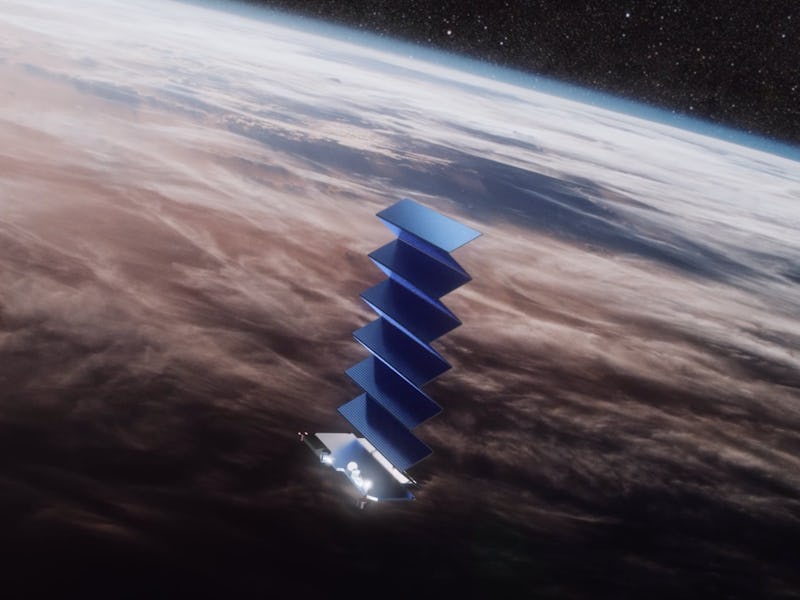Musk Reads: How to register for Starlink service news
Starlink takes shape and lunar Starship is detailed. Will Mars-based humans evolve?

Starlink takes shape and lunar Starship is detailed. Will Mars-based humans evolve? It’s Musk Reads: SpaceX Edition #177.
A version of this article appeared in the “Musk Reads” newsletter. Sign up for free here.
Musk quote of the week
“Chartering a dedicated 747 flight around the world costs less than buying a small, single engine turboprop plane. In the same way, a giant reusable rocket flight is way cheaper than a tiny expendable rocket that can be used only once.”
- Read more about Musk’s plan for reusable rockets.
SpaceX Starlink
Starlink, SpaceX’s satellite internet constellation, is taking shape. Ahead of a planned beta test later this year, the Starlink website has started taking users’ information to receive updates on news and service availability in their area. Interested customers can provide their email address, ZIP code, and country to stay in the loop about next steps.
The news comes as SpaceX board director Steve Jurvetson shared via Twitter that he’d tried out the nascent service. Although he wouldn’t share information about speed, he explained that members of the board set up receivers to see how fast they would connect to the emergent constellation. Read more.
In other Starlink news: * Musk revealed that Starlink’s latency will be around 20 milliseconds, but a version 2 at a low altitude could reach eight milliseconds. * The FCC has “serious doubts” that Starlink and others can meet the grade for low-latency internet service in the short term. It means SpaceX will likely be unable to bid for rural broadband funding as a low-latency provider. Read more. * SpaceX sent up 58 Starlink satellites on Saturday. There were two fewer satellites on board than normal because this was the first mission to ride-share with another satellite; in this case three from San Francisco-based firm Planet. Read more. * An incredible video shows the fairing deploy sequence during the June 4 mission. Read more.
In other SpaceX news…
Moon-bound Starships could see a few tweaks, which could help it support a lunar base. On Tuesday, Musk wrote the team was “working on new legs” to help it land on rocky surfaces. The ship is designed to support practically all of SpaceX’s missions, but Musk noted that the lack of atmosphere on the Moon could mean the ships wouldn’t need “heatshield or flaps or big gas thruster packs.” The plans came as NASA administrator Jim Bridenstine declared the agency would “once again let private companies innovate” for the planned Moon base as part of the Artemis program. Read more.
What’s a day in the life of a SpaceX astronaut like? Bob Behnken and Doug Hurley are the first two astronauts to wear that title. Read more.
NASA’s Perseverance rover is set to launch on July 17 using an Atlas V–541 rocket taking off from Cape Canaveral Air Force Station in Florida. The Atlas V, a United Launch Alliance rocket, has been described as “America’s space workhorse." Read more.
Rocket Lab, the space-faring firm that’s focused on small satellites, launched its “Don’t Stop Me Now” mission. Read more.
What’s next for SpaceX: SpaceX is expected to launch the 10th batch of Starlink satellites on June 22 from Launch Complex 39A at the Kennedy Space Center at 6:20 p.m. Eastern time.
Musk Reads mailroom
Lawrence Vanell writes:
I just took a look at the control board on the Boeing Starliner. It totally ignores the “keep it simple stupid” guideline! I would be interested to hear how the astronauts feel about a comparison between the Starliner and Dragon controls.
Interestingly, it seems the cluttered control board suits the astronauts very well. Sunita Williams, expected to fly on the Starliner, told The Verge in 2018 that “there are hand controllers on the Boeing spacecraft, which always makes a pilot happy,” while SpaceX’s touch-focused setup led to reactions like: “Oh, that’s interesting. How are you going to handle that problem if you had to manually fly?”
Perhaps the first successful flight of Crew Dragon will reassure other astronauts that SpaceX’s bold new approach is nothing to worry about.
Derck van Schuylenburch writes:
When people intending to populate Mars arrive there they will experience gravity that is ~1/3 of the gravity experience on earth, but they can manage. When their Martian children were to visit earth, for whatever reason, they will experience gravity that is ~3 more than the gravity they experience on Mars, they cannot possibly manage. (Even at rest their hearts will have to pump blood that is, all of a sudden, ~3 times heavier than normal.) Thus the human species will immediately commence bifurcating into 2 distinct species.
This is an issue that’s been raised before. Rice University professor Scott Solomon told Inverse in May 2019 that humans could rapidly evolve thanks to high levels of radiation. They could develop denser bones to overcome the effects of reduced gravity; they could become more near-sighted in the smaller areas of Mars; and they could develop to use oxygen more efficiently. They may also lose their immune system in the sterile environment, which could make contact with Earth-humans deadly.
Got any comments or queries? Don’t forget to send them over to muskreads@inverse.com.
Photo of the week
Stephen Marr fantastically captures the Starlink launch.
Got any photos or videos you’d like to share? Feel free to send them over to muskreads@inverse.com.
The ultra-fine print
This has been Musk Reads: SpaceX Edition #177, the weekly rundown of essential reading about futurist and entrepreneur Elon Musk. I’m Mike Brown, an innovation journalist for Inverse.
- Email me directly at mike.brown@inverse.com and follow Inverse on Twitter @inversedotcom. Follow me on Twitter @mikearildbrown.
- Got any comments or queries? Don’t forget to send them over to muskreads@inverse.com.
A version of this article appeared in the “Musk Reads” newsletter. Sign up for free here.